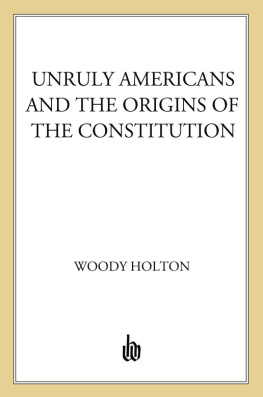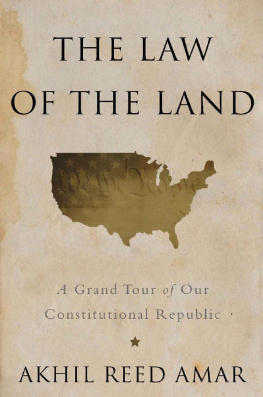The Precedents
and Principles
We Live By
AMERICAS
UNWRITTEN
CONSTITUTION
ALSO BY AKHIL REED AMAR
Americas Constitution
The Bill of Rights
The Constitution and Criminal Procedure
AMERICAS
UNWRITTEN
CONSTITUTION
The Precedents and Principles
We Live By
AKHIL REED AMAR
BASIC BOOKS
A MEMBER OF THE PERSEUS BOOKS GROUP
New York
Copyright 2012 by Akhil Reed Amar
Published by Basic Books,
A Member of the Perseus Books Group
All rights reserved. No part of this book may be reproduced in any manner whatsoever without written permission except in the case of brief quotations embodied in critical articles and reviews. For information, address Basic Books, 250 West 57th Street, 15th Floor, New York, NY 10107
Books published by Basic Books are available at special discounts for bulk purchases in the United States by corporations, institutions, and other organizations. For more information, please contact the Special Markets Department at the Perseus Books Group, 2300 Chestnut Street, Suite 200, Philadelphia, PA 19103, or call (800) 810-4145, ext. 5000, or e-mail .
Designed by Janet Tingey
Library of Congress Cataloging-in-Publication Data
Amar, Akhil Reed.
Americas unwritten constitution : the precedents and principles we live by / Akhil Reed Amar.
p.cm.
Includes bibliographical references and index.
ISBN 978-0-465-03309-6
1. Constitutional historyUnited States. 2. Constitutional lawSocial aspectsUnited States. I. Title.
KF4541.A875 2012
342.73029dc23
2012012363
10 9 8 7 6 5 4 3 2 1
For God, for country, and for Yale and alsoalwaysfor family
CONTENTS
T HE EIGHT THOUSAND WORDS OF Americas written Constitution only begin to map out the basic ground rules that actually govern our land. For example, the idea that racial segregation is inherently unequal does not explicitly appear in the terse text. The First Amendment prevents Congress from abridging various freedoms, but the Amendment does not expressly protect these freedoms from abridgment by the president or state governments. None of the Constitutions early amendments explicitly limits state governments. Although everyone today refers to these early amendments as the Bill of Rights, this phrase, too, is unwritten. The phrases separation of powers, checks and balances, and the rule of law are also absent from the written Constitution, but all these things are part of Americas working constitutional systempart of Americas unwritten Constitution.
Consider also the axiom that all voters must count equallyone person, one votein state elections and in elections to the U.S. House of Representatives. No clause of the written Constitution expressly proclaims this axiom. At the Founding, this axiom was not widely honored in practice; nor did it sweep the land at any time over the next 175 years. And yet today, this unwritten rulea rule supported by every Supreme Court justice, by both major parties, by opinion leaders of all stripes, and by an overwhelming majority of ordinary citizensforms the bedrock of the American system of government.
Of course, much (though not all) of Americas unwritten Constitution does involve written materials, such as venerable Supreme Court opinions, landmark congressional statutes, and iconic presidential proclamations. These materials, while surely written texts, are nonetheless distinct from the written Constitution and are thus properly described by lawyers and judges as parts of Americas unwritten Constitution.
Americas unwritten Constitution encompasses not only rules specifying the substantive content of the nations supreme law but also rules clarifying the methods for determining the meaning of this supreme law. Since the written Constitution does not come with a complete set of instructions about how it should be construed, we must go beyond the text to make sense of the text.
Without an unwritten Constitution of some sort, we would not even be able to properly identify the official written Constitution. In the late 1780s, several different versions of the text circulated among the citizenry, each calling itself the Constitution. Each featured slightly different punctuation, capitalization, and wording. Which specific written version was and is the legal Constitution? To find the answer, we must necessarily go beyond these dueling texts themselves and consider things outside the texts. (When we do, we shall discover that the hand-signed parchment now on display in the National Archives is not and never was the official legal version of the Constitution, though this celebrated parchment does, happily, closely approximate the official text.) With a proper analytic framework in place, we shall also be poised to resolve a debate that has recently erupted about whether the Constitution contains a consciously Christian reference to Jesus in the phrase the Year of our Lorda phrase that appeared in many but not all of the self-described written Constitutions making the rounds in the 1780s.
WHAT, EXACTLY, IS THE UNWRITTEN Constitution and how can we find it? How can Americans be faithful to a written Constitution even as we venture beyond it? What is the proper relationship between the document and the doctrinethat is, between the written Constitution and the vast set of judicial rulings purporting to apply the Constitution? In particular, how should we think about various landmark casesfrom Brown v. Board of Education and Gideon v. Wainwright to Reynolds v. Sims and Roe v. Wadethat critics over the years have assailed as lacking proper foundations in the written Constitution?
This book tackles these and related questions. In brief, I argue that the written Constitution itself invites recourse to certain things outside the textthings that form Americas unwritten Constitution. When viewed properly, Americas unwritten Constitution supports and supplements the written Constitution without supplanting it.
Consider the Constitutions Ninth Amendment, which affirms the reality of various rights that are not textually enumerat[ed]rights that are concededly not listed in the document itself. To take this amendment seriously, Americans must go beneath and beyond the Constitutions textually enumerated rights. For instance, even though the text fails to specify a criminal defendants entitlement to introduce reliable physical evidence of his innocence, surely this textual omission should not doom a defendants claim of right.
The Ninth Amendment is not the only textual portal welcoming us to journey beyond the Constitutions text, and the trail of unenumerated rights is only one of several routes worth traveling in search of Americas unwritten Constitution. In the pages that follow, we shall revisit many of our Constitutions most important topics, from federalism, congressional practice, executive power, and judicial review to race relations, womens rights, popular constitutionalism, criminal procedure, voting rights, and the amendment process.
Next page






